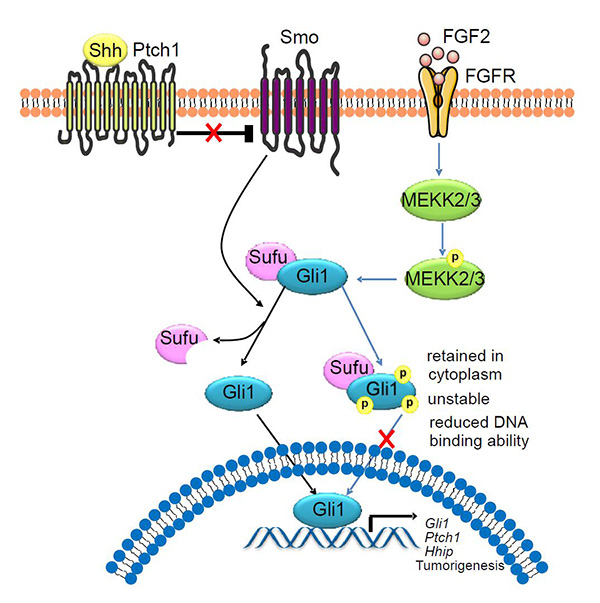On April 17th,2018, Dr. Hai Song Laboratory published a research paper on Oncogene entitled “ MEKK2 and MEKK3 suppress Hedgehog pathway-dependent medulloblastoma by inhibiting GLI1 function ”. The critical role of protein kinases MEKK2/3 in the FGF-mediated inhibition on Hedgehog signaling and the underlying mechanisms were revealed.
Hedgehog signaling (Hh) regulates cell proliferation, differentiation and organ formation, which plays a crucial role in many aspects of embryonic development. In postnatal physiology, Hh pathway has key roles in tissue homeostasis and regeneration in the epithelia of the skin, intestine, lung, etc. Hh signaling transduction is initiated through ligand binding and inactivating the Hh receptor Patched (PTCH). This relieves PTCH repression on the seven-pass transmembrane protein Smoothened (SMO). GLI are released into the nucleus following activated SMO interacting with SUFU-GLI protein complex and initiate the transcription of Hh target genes. As a member of Hh target genes, the aberrant activation of GLI1 is associated with various types of human cancer, including basal cell carcinoma, medulloblastoma, etc. Thus, the discovery of the critical proteins that can regulate GLI1 or Hh signaling provides a certain theoretical significanceto clinical therapies against Hh pathway-dependent carcinoma.
Previous studies reported that FGF2 blocks Sonic hedgehog signaling in neuronal precursors and tumor cells, but the inhibitory mechanism was not well-elucidated.
MEKK2 and MEKK3 which suppress GLI1 transcriptional activity were identified by kinase screening through GLI1 luciferase reporter assay. MEKK2/3 can be activated by FGF2. Furthermore, MEKK2/3 can interact with GLI1 and directly phosphorylate it at multiple Ser/Thr sites, increasing the association of GLI1 with SUFU. In sufu-knockdown cell lines, the transcriptional activity of phosphorylated GLI1 was inhibited, regardless of the nucleus retention of GLI1,due to the reduction on GLI1 DNA-binding ability. Meanwhile, phosphorylated GLI1 had reduced stability which can be rescued by MG132 treatment. Functionally, cell growth of and the tumor volume of subcutaneously injected MEKK2/3-overexpressed medulloblastoma (Daoy) was decreased. FGF2 inhibited Hh signaling in wild-type NIH3T3 or Daoy cells but not in MEKK2/3-DKO cells. Taken together, these results suggested that FGF2 represses Hh signaling through activating MEKK2/3, elucidating a novel molecular mechanism of the regulation of GLI1.

The diagram shows that activated MEKK2/3 by FGF2 directly phosphorylate GLI1. Phosphorylation results in reduced GLI1 protein stability, transcriptional activity, and tumorigenesis potency.
Ph.D. students Lu Jinqiu and Liu Liangsheng in Dr. Song’s group are co-first authors. Dr. Song is the corresponding author of this article.This work was supported by the National Natural Science Foundation of China, the Zhejiang Provincial Natural Science Foundation of China to HS. Hai Song is a scholar in the National 1000 Young Talents Program.



